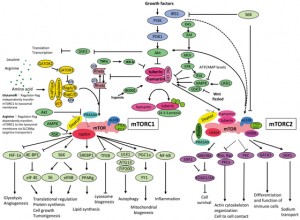<Title:> Tuberous Sclerosis Complex
<Author(s):> Mari Wataya-kaneda
<Corresponding author E-Mill:> mkaneda(at)sahs.med.osaka-u.ac.jp
<Abstract:> Tuberous sclerosis complex (TSC) is an autosomal dominant inherited disease characterized by systemic hamartomas, neuropsychiatric symptoms known as TAND (TSC-associated neuropsychiatric disorders), and vitiligo. These symptoms are attributed to the constant activation of mechanistic target of rapamycin complex 1 (mTORC1) caused by genetic mutations in the causative genes TSC1 or TSC2. The elucidation of the pathogenesis of this disease and advances in diagnostic technologies have led to dramatic changes in the diagnosis and treatment of TSC. Diagnostic criteria have been created at a global level, and mTORC1 inhibitors have emerged as therapeutic agents for this disease. Previously, the treatment strategy was limited to symptomatic treatments such as surgery. Inhibitors of mTORC1 are effective against all symptoms of TSC, but they also have systemic side effects. Therefore, the need for a cross-disciplinary, collaborative medical care system has increased, resulting in the establishment of a practice structure known as the “TSC Board.” Furthermore, to reduce the side effects of systemic administration of mTORC1 inhibitors, a topical formulation of mTORC1 inhibitor was developed in Japan for the treatment of skin lesions caused by TSC. This report summarizes the pathogenesis and current status of TSC and the contribution of the Neurocutaneous Syndrome Policy Research Group to the policies of the Ministry of Health, Labor, and Welfare with respect to this rare, intractable disease.
<Keywords:> tuberous sclerosis complex, mTORC1, diagnostic criteria, ministry of health labor and welfare, topical formulation of mTORC1 inhibitor
<URL:> https://www.jstage.jst.go.jp/article/kjm/advpub/0/advpub_2023-0011-IR/_html


![Cutaneous Metaplastic Synovial Cyst: Case Report and Literature Review from the Dermatological Point of View [Published online in advanced , by J-STAGE]](http://kjm.pupu.jp/blog/wp-content/uploads/2016/06/2016-0002-CR-100x100.jpg)
![COVID-19: Stay Cool toward Corticosteroids [Published online in advanced , by J-STAGE]](http://kjm.pupu.jp/blog/wp-content/uploads/2020/05/2020-0007-LE-100x100.jpg)
![Development of Cardiac Regenerative Medicine Using Human iPS Cell-derived Cardiomyocytes [Published online in advanced , by J-STAGE]](http://kjm.pupu.jp/blog/wp-content/uploads/2020/08/2020-0009-IR-100x100.jpg)
![Leadership Training of Surgery in US [Published online Keio J Med, 66, 54-54, by J-STAGE]](http://kjm.pupu.jp/blog/wp-content/uploads/2017/09/66-004-ABST-100x100.jpg)
![COVID-19: Stay Cool toward Corticosteroids [Published online Keio J Med, 69, 27-29, by J-STAGE]](http://kjm.pupu.jp/blog/wp-content/uploads/2020/06/2020-0007-LE-100x100.jpg)
![Anemia Treatment by Erythropoiesis-stimulating Agents during the 6 Months before the Initiation of Hemodialysis: Comparison of Darbepoetin Alfa and Continuous Erythropoietin Receptor Activator [Published online Keio J Med, 66, 44-50, by J-STAGE]](http://kjm.pupu.jp/blog/wp-content/uploads/2017/09/2016-0009-OA-100x100.jpg)
![Cardiopulmonary Resuscitation Training in Schools: A Comparison of Trainee Satisfaction among Different Age Groups [Published online in advanced , by J-STAGE]](http://kjm.pupu.jp/blog/wp-content/uploads/2016/06/2015-0009-OA-100x100.jpg)
![RT-PCR Screening Tests for SARS-CoV-2 with Saliva Samples in Asymptomatic People: Strategy to Maintain Social and Economic Activities while Reducing the Risk of Spreading the Virus [Published online Keio J Med, 70, 35-43, by J-STAGE]](http://kjm.pupu.jp/blog/wp-content/uploads/2021/06/2021-0003-OA-100x100.jpg)
![Clinical Features of Febrile Urinary Tract Infection Caused by Extended-spectrum Beta-lactamase-producing <i>Escherichia Coli</i> in Children [Published online in advanced , by J-STAGE]](http://kjm.pupu.jp/blog/wp-content/uploads/2019/08/2019-0005-OA-100x100.jpg)
![A Heart-shaped Sleeve Simplifies Intramedullary Tibial Nail Insertion when Using the Suprapatellar Approach [Published online in advanced , by J-STAGE]](http://kjm.pupu.jp/blog/wp-content/uploads/2017/07/2017-0001-OA-100x100.jpg)